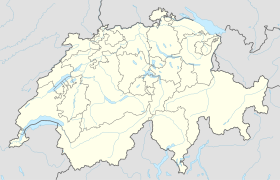Mollis
| Mollis | ||
|---|---|---|
| State : |
|
|
| Canton : |
|
|
| District : | No district division | |
| Political community : | Glarus North | |
| Postal code : | 8753 | |
| former BFS no. : | 1617 | |
| UN / LOCODE : | CH MOL | |
| Coordinates : | 724 272 / 217 172 | |
| Height : | 433 m above sea level M. | |
| Area : | 21.83 km² | |
| Residents: | 3337 (December 31, 2010) | |
| Population density : | 153 inhabitants per km² | |
| map | ||
|
|
||

Mollis is a former political municipality in the Swiss canton of Glarus . Since January 1, 2011, their area has been part of the newly formed municipality of Glarus Nord .
geography
Mollis is located in the Glarner Unterland and borders the Linth Canal and the Walensee in the north. To the east is the former municipality of Filzbach , to the south of Ennenda , to the south-west of Netstal and to the west of Näfels , Oberurnen and Niederurnen .
Mollis is the western starting point of the Kerenzerpass road, which leads along the southern flank of the Walensee towards the Rhine Valley. The hamlet of Beglingen, which has always been part of Mollis, is also located on Kerenzerbergstrasse.
From Mollis the Linth runs in the " Escherkanal ".
history
From the year 15 BC The Romans ruled over the area of today's Mollis, which was previously settled by Raiders . Numerous finds point to the Roman past, including the place name, which is derived either from mollis ('soft', because of the swampy area) or from mola ('mill'). Around 490 the Romans were ousted by the Alemanni who settled here.
In the 9th century the Säckingen monastery received extensive property in the Glarus region, some of it in the area of the municipality of Mollis. The village was first mentioned in writing in 1288.
In 1319 a chapel built in 1280 was raised to the status of a church, in 1395 the separation from the Säckingen monastery was completed, from 1444 Mollis was a parish independent of Glarus. The pastor Fridolin Brunner , who was in office from 1523 to 1525, initiated the Reformation, but it was not until 1529 that it finally prevailed. Today 's church by Hans Ulrich Grubenmann dates from 1761.
In the 18th century cotton spinning and later hand weaving led to some prosperity. During the Helvetic period (1798–1803) Mollis was affected by armed conflicts and billeting due to its location. The 19th century saw a further expansion of the textile industry (fabric printing), the first school building was built in 1852 and the connection to the rail network in 1859.
As part of the Glarus community reform , which is based on a regional community resolution of May 7, 2006, Mollis was merged on January 1, 2011 with the communities of Bilten , Filzbach, Mühlehorn , Näfels, Niederurnen, Oberurnen and Obstalden to form the new community of Glarus Nord .
Economy, transport
Mollis shares a train station with Näfels on the regional line Rapperswil - Glarus - Linthal . The village center is served by the Glarner bus (Bilten- / Ziegelbrücke-Niederurnen-Näfels-Mollis-Filzbach-Obstalden-Mühlehorn). The concessionaire for the bus line is the Swiss Federal Railways , which awards the transport contract to the Emil Niederer bus company in Filzbach. Weesen train station is in the north of the municipality .
In the north, the municipality has access to the trunk road network via the Niederurnen (44) and Weesen (45) junctions on the A3 motorway . The main road 3 Basel - Castasegna ( Graubünden ) leads through the village .
The former Mollis military airfield is located on the plain .
Personalities
Born in Mollis
- Heinrich Loriti, called Glarean (1488–1563), humanist and polymath
- Johann Melchior Schuler (1779–1859), Protestant clergyman and local researcher
- Dietrich Schindler (1795–1882), Swiss statesman and art collector
- Friedrich Wilhelm Schindler (1856–1920), Austrian entrepreneur and inventor
Associated with Mollis
- Fridolin Brunner (1498–1570), Swiss Protestant pastor and reformer in Mollis 1523–1525
- Rudolf Leuzinger (1826–1896), Swiss cartographer, lived and worked in Mollis from 1881–1896
- Fridolin Schuler (1832–1903), Swiss doctor and the first state factory inspector in Switzerland, was a doctor in Mollis from 1855 to 1877
- Fritz Zwicky (1898–1974), Swiss physicist and astronomer, hometown and burial place of Zwicky
Web links
- Karin Marti-Weissenbach: Mollis. In: Historical Lexicon of Switzerland .








